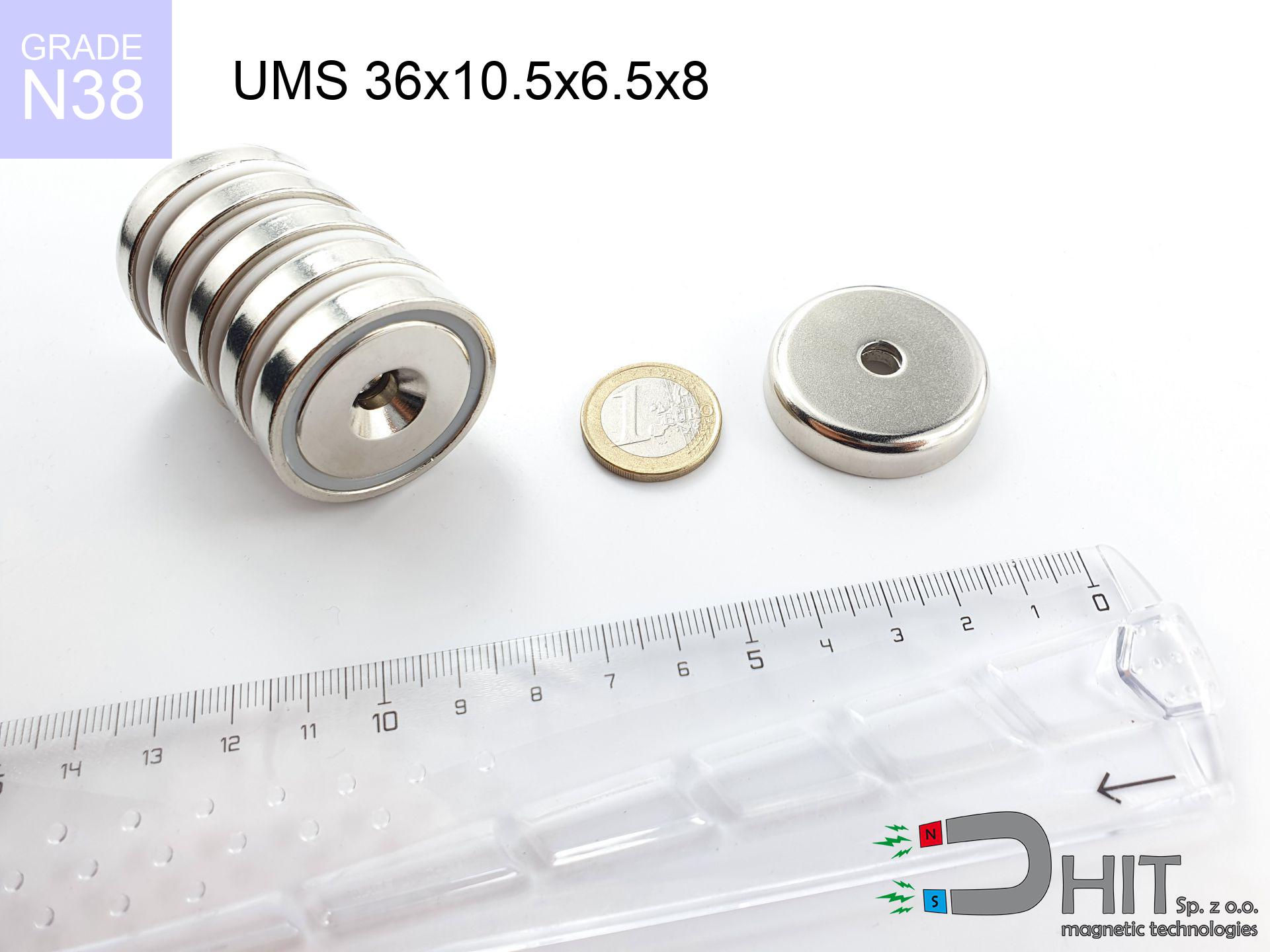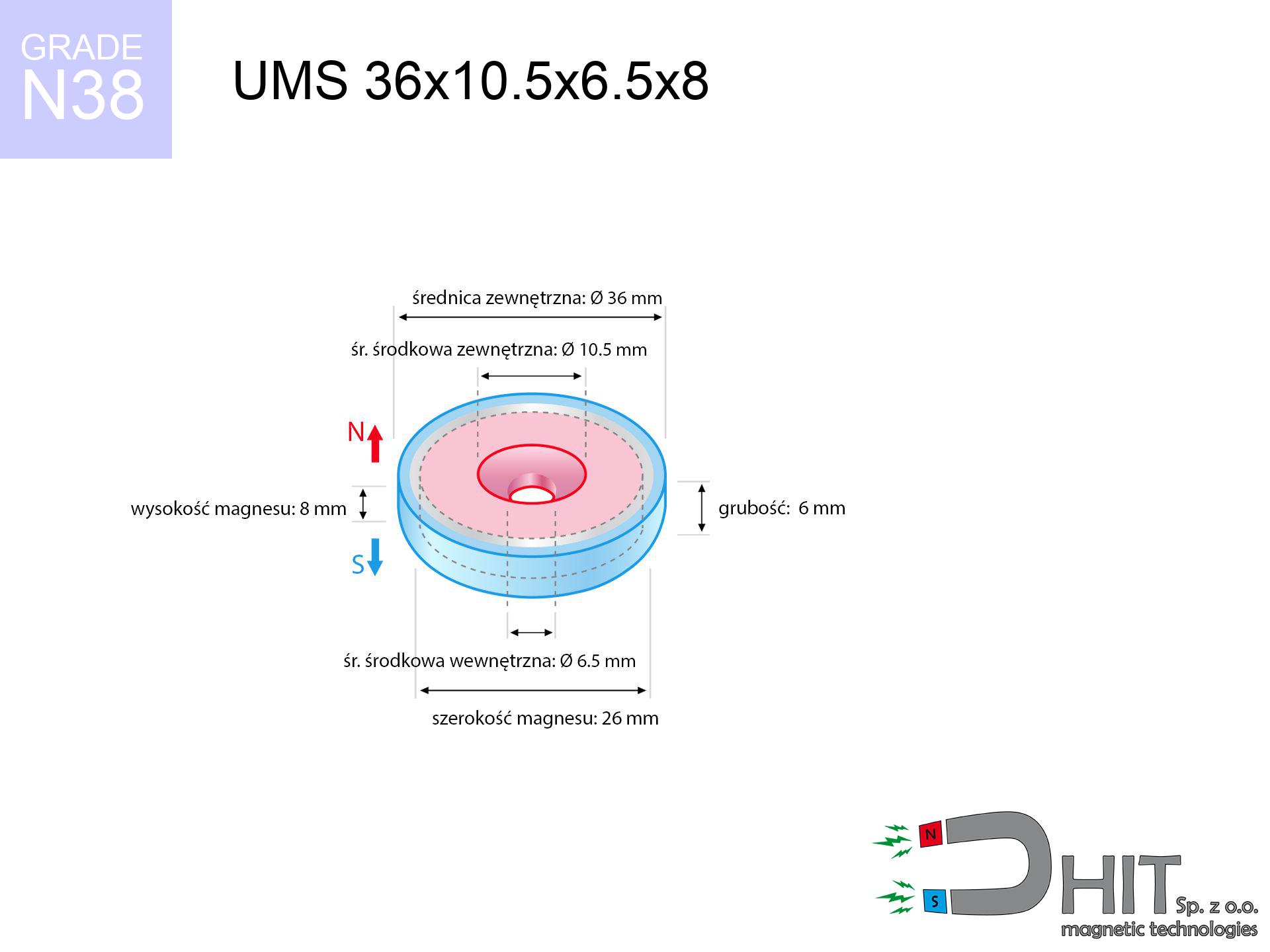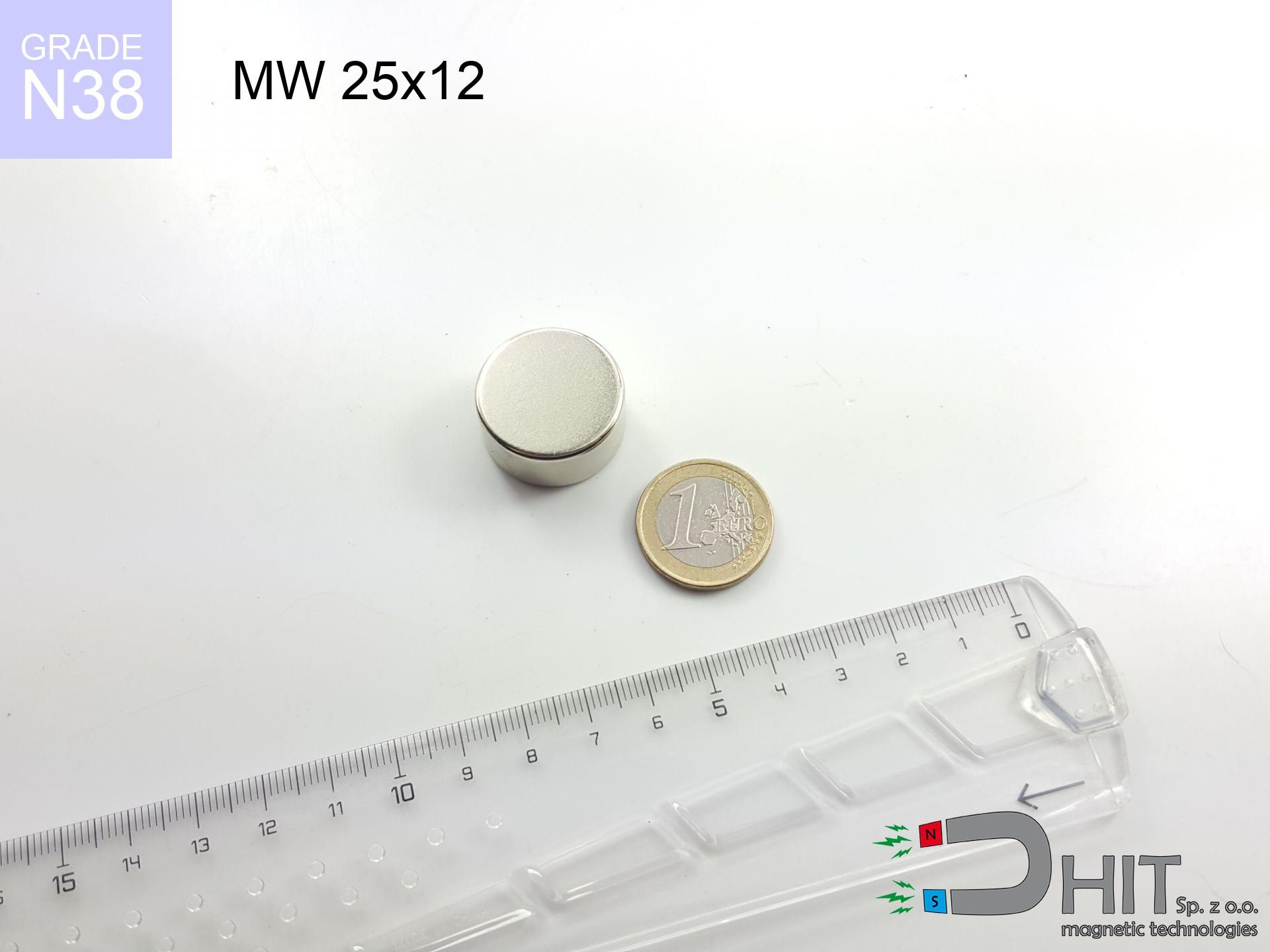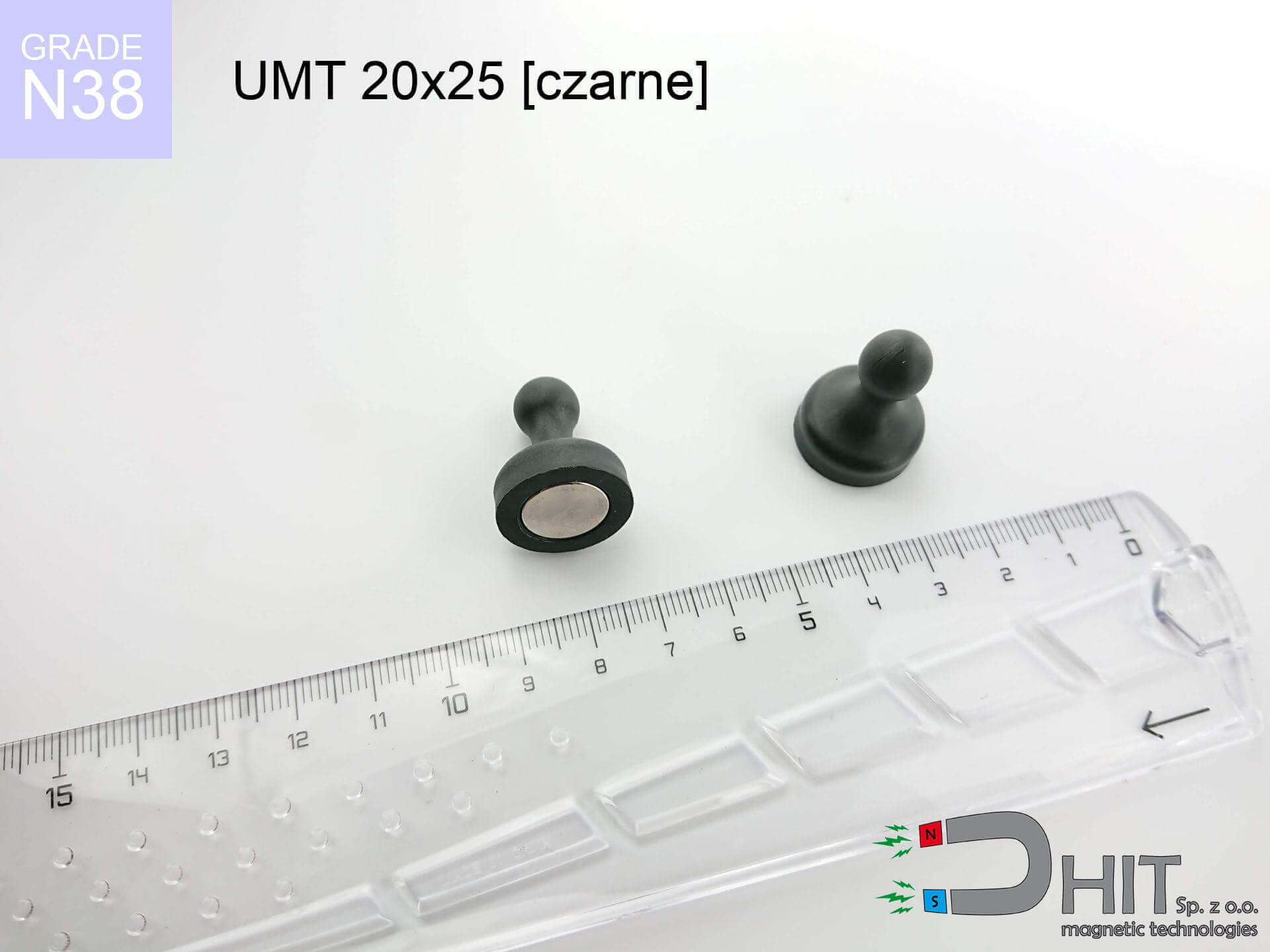UMS 36x10.5x6.5x8 / N38 - conical magnetic holder
conical magnetic holder
Catalog no 220330
GTIN/EAN: 5906301814207
Diameter Ø
36 mm [±1 mm]
cone dimension Ø
10.5x6.5 mm [±1 mm]
Height
8 mm [±1 mm]
Weight
45 g
Magnetization Direction
↑ axial
Load capacity
29.00 kg / 284.39 N
Coating
[NiCuNi] Nickel
22.94 ZŁ with VAT / pcs + price for transport
18.65 ZŁ net + 23% VAT / pcs
bulk discounts:
Need more?
Pick up the phone and ask
+48 22 499 98 98
alternatively get in touch using
our online form
the contact page.
Lifting power and structure of a neodymium magnet can be reviewed with our
online calculation tool.
Orders placed before 14:00 will be shipped the same business day.
Technical parameters - UMS 36x10.5x6.5x8 / N38 - conical magnetic holder
Specification / characteristics - UMS 36x10.5x6.5x8 / N38 - conical magnetic holder
| properties | values |
|---|---|
| Cat. no. | 220330 |
| GTIN/EAN | 5906301814207 |
| Production/Distribution | Dhit sp. z o.o. |
| Country of origin | Poland / China / Germany |
| Customs code | 85059029 |
| Diameter Ø | 36 mm [±1 mm] |
| cone dimension Ø | 10.5x6.5 mm [±1 mm] |
| Height | 8 mm [±1 mm] |
| Weight | 45 g |
| Magnetization Direction | ↑ axial |
| Load capacity ~ ? | 29.00 kg / 284.39 N |
| Coating | [NiCuNi] Nickel |
| Manufacturing Tolerance | ±1 mm |
Magnetic properties of material N38
| properties | values | units |
|---|---|---|
| remenance Br [min. - max.] ? | 12.2-12.6 | kGs |
| remenance Br [min. - max.] ? | 1220-1260 | mT |
| coercivity bHc ? | 10.8-11.5 | kOe |
| coercivity bHc ? | 860-915 | kA/m |
| actual internal force iHc | ≥ 12 | kOe |
| actual internal force iHc | ≥ 955 | kA/m |
| energy density [min. - max.] ? | 36-38 | BH max MGOe |
| energy density [min. - max.] ? | 287-303 | BH max KJ/m |
| max. temperature ? | ≤ 80 | °C |
Physical properties of sintered neodymium magnets Nd2Fe14B at 20°C
| properties | values | units |
|---|---|---|
| Vickers hardness | ≥550 | Hv |
| Density | ≥7.4 | g/cm3 |
| Curie Temperature TC | 312 - 380 | °C |
| Curie Temperature TF | 593 - 716 | °F |
| Specific resistance | 150 | μΩ⋅cm |
| Bending strength | 250 | MPa |
| Compressive strength | 1000~1100 | MPa |
| Thermal expansion parallel (∥) to orientation (M) | (3-4) x 10-6 | °C-1 |
| Thermal expansion perpendicular (⊥) to orientation (M) | -(1-3) x 10-6 | °C-1 |
| Young's modulus | 1.7 x 104 | kg/mm² |
Material specification
| iron (Fe) | 64% – 68% |
| neodymium (Nd) | 29% – 32% |
| boron (B) | 1.1% – 1.2% |
| dysprosium (Dy) | 0.5% – 2.0% |
| coating (Ni-Cu-Ni) | < 0.05% |
Ecology and recycling (GPSR)
| recyclability (EoL) | 100% |
| recycled raw materials | ~10% (pre-cons) |
| carbon footprint | low / zredukowany |
| waste code (EWC) | 16 02 16 |
Other offers
Strengths and weaknesses of neodymium magnets.
Advantages
- They do not lose strength, even over around ten years – the drop in strength is only ~1% (according to tests),
- Neodymium magnets prove to be remarkably resistant to loss of magnetic properties caused by external field sources,
- A magnet with a shiny gold surface has an effective appearance,
- They feature high magnetic induction at the operating surface, which increases their power,
- Neodymium magnets are characterized by extremely high magnetic induction on the magnet surface and can work (depending on the form) even at a temperature of 230°C or more...
- Considering the ability of flexible forming and adaptation to individualized requirements, magnetic components can be produced in a broad palette of geometric configurations, which makes them more universal,
- Versatile presence in modern technologies – they are utilized in mass storage devices, electric motors, advanced medical instruments, as well as complex engineering applications.
- Compactness – despite small sizes they provide effective action, making them ideal for precision applications
Limitations
- They are prone to damage upon too strong impacts. To avoid cracks, it is worth securing magnets in special housings. Such protection not only protects the magnet but also improves its resistance to damage
- Neodymium magnets decrease their strength under the influence of heating. As soon as 80°C is exceeded, many of them start losing their power. Therefore, we recommend our special magnets marked [AH], which maintain durability even at temperatures up to 230°C
- Magnets exposed to a humid environment can corrode. Therefore during using outdoors, we suggest using waterproof magnets made of rubber, plastic or other material protecting against moisture
- We suggest casing - magnetic mount, due to difficulties in creating nuts inside the magnet and complicated shapes.
- Potential hazard related to microscopic parts of magnets pose a threat, if swallowed, which gains importance in the context of child health protection. It is also worth noting that small elements of these products can disrupt the diagnostic process medical when they are in the body.
- Due to expensive raw materials, their price is higher than average,
Lifting parameters
Optimal lifting capacity of a neodymium magnet – what it depends on?
- on a plate made of structural steel, optimally conducting the magnetic field
- with a cross-section minimum 10 mm
- characterized by smoothness
- under conditions of no distance (metal-to-metal)
- under axial force direction (90-degree angle)
- in neutral thermal conditions
Practical aspects of lifting capacity – factors
- Gap between magnet and steel – every millimeter of distance (caused e.g. by varnish or unevenness) significantly weakens the magnet efficiency, often by half at just 0.5 mm.
- Pull-off angle – note that the magnet holds strongest perpendicularly. Under shear forces, the capacity drops significantly, often to levels of 20-30% of the nominal value.
- Plate thickness – too thin sheet causes magnetic saturation, causing part of the flux to be wasted into the air.
- Steel type – low-carbon steel attracts best. Alloy admixtures decrease magnetic permeability and holding force.
- Plate texture – ground elements guarantee perfect abutment, which increases field saturation. Uneven metal reduce efficiency.
- Temperature influence – high temperature weakens magnetic field. Too high temperature can permanently damage the magnet.
Lifting capacity was determined using a smooth steel plate of suitable thickness (min. 20 mm), under perpendicular pulling force, whereas under shearing force the lifting capacity is smaller. Additionally, even a slight gap between the magnet’s surface and the plate reduces the load capacity.
H&S for magnets
Mechanical processing
Fire hazard: Neodymium dust is highly flammable. Do not process magnets in home conditions as this may cause fire.
No play value
Absolutely store magnets out of reach of children. Risk of swallowing is high, and the effects of magnets clamping inside the body are very dangerous.
Avoid contact if allergic
Warning for allergy sufferers: The nickel-copper-nickel coating consists of nickel. If skin irritation happens, cease working with magnets and wear gloves.
Implant safety
Medical warning: Neodymium magnets can deactivate heart devices and defibrillators. Do not approach if you have electronic implants.
Magnetic media
Avoid bringing magnets near a purse, computer, or screen. The magnetic field can irreversibly ruin these devices and wipe information from cards.
Fragile material
Beware of splinters. Magnets can fracture upon violent connection, ejecting shards into the air. Wear goggles.
Maximum temperature
Standard neodymium magnets (grade N) lose magnetization when the temperature surpasses 80°C. Damage is permanent.
Precision electronics
A powerful magnetic field interferes with the functioning of compasses in phones and navigation systems. Keep magnets close to a smartphone to prevent breaking the sensors.
Powerful field
Before starting, read the rules. Uncontrolled attraction can destroy the magnet or injure your hand. Think ahead.
Serious injuries
Large magnets can break fingers in a fraction of a second. Under no circumstances put your hand betwixt two attracting surfaces.







![UMP 107x40 [M8+M10] GW F 400 kg / N38 - search holder UMP 107x40 [M8+M10] GW F 400 kg / N38 - search holder](https://cdn3.dhit.pl/graphics/products/ump107x40-m8+m10-gw-f-400-kg-mup.jpg)

